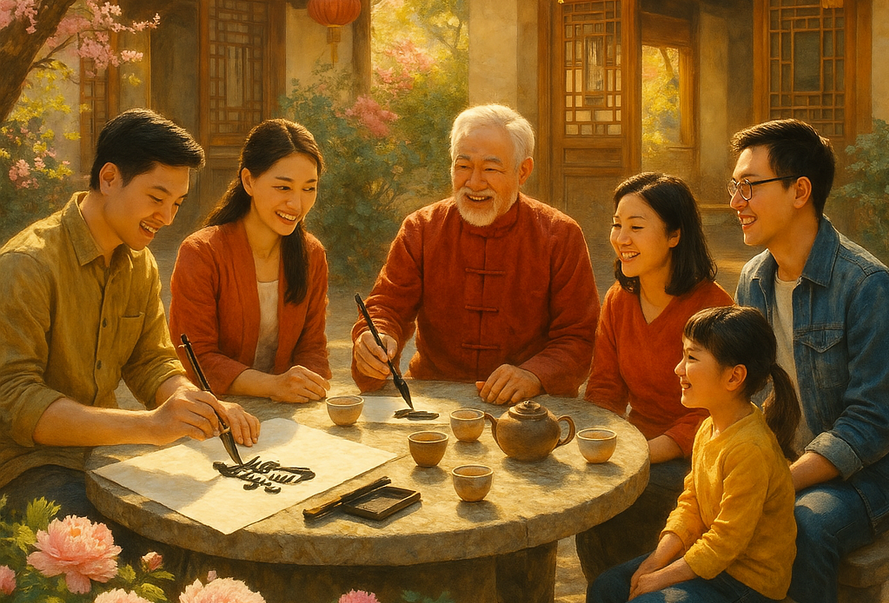Views: 58
National identity as a catalyst for collective progress
Frans Vandenbosch 方腾波 11.04.2025

A synthesis of cultural heritage and modern nationalism
Introduction
The interplay of peace (和平, hépíng), harmony (和谐, héxié), and happiness (幸福, xìngfú) in China is deeply rooted in its philosophical traditions and revitalised through modern governance frameworks. These values, central to the Communist Party of China (CPC) vision of national rejuvenation, are inextricably linked to a form of cultural statecraft that prioritises collective well-being, cultural confidence, and resistance to external interference.
This essay explores how China’s historical ethos and contemporary policies intertwine to create a unique model where collective ethos serves as both a vehicle for and a manifestation of societal harmony and individual fulfilment. This study synthesises historical, cultural, and policy-driven perspectives to foreground China’s unique integration of civilisational identity and societal well-being.
1. Historical and cultural foundations
China’s emphasis on harmony dates back to Confucianism, Daoism, and Buddhism, which framed societal equilibrium as a reflection of cosmic order. Confucius’s assertion that “harmony is prized” (和为贵, hé wéi guì) underscored the moral imperative of ethical governance and familial duty. Daoist philosophy further reinforced this through its emphasis on aligning human activity with the natural “Way” (道, dào), a principle mirrored in modern policies like the “Ecological Civilisation” initiative.
Symbolism in cultural values
Traditional symbols continue to shape national identity:
– Phoenix (凤): Represents love, beauty, and peace, embodying Confucian virtues of benevolence and righteousness. [1]
– Yin-Yang (阴阳): Symbolises balance and interdependence, a concept integrated into China’s approach to governance and international relations.
– Lotus Flower (荷花): Signifies resilience, reflecting the CPC goal of overcoming historical humiliations to achieve prosperity.
These symbols are not relics of the past but active components to support and promote cultural confidence. For instance, the “Chinese Dream” (中国梦) invokes the phoenix’s symbolism to frame national progress as a collective rebirth.
2. Modern governance: Institutionalising harmony
The CPC has institutionalised harmony through policies that merge socialist principles with cultural heritage. Key frameworks include:
A. Socialist rule of law
The 2014 Fourth Plenum codified the “Socialist Rule of Law, “prioritising societal stability over individual rights. This legal framework positions the state as the guarantor of collective harmony, criminalising actions deemed disruptive to “social management”. For example, the 2016 Cybersecurity Law mandates: “Orderly Public Discourse” (有序公共话语), justifying censorship as a safeguard against destabilising misinformation.
B. Poverty alleviation and common prosperity
Between 2013 and 2021, China lifted 98.99 million rural residents out of poverty, a feat the National Bureau of Statistics attributes to the “Targeted Poverty Alleviation” strategy. This policy aligns with the Confucian ideal of Xiaokang Society (小康社会), or moderate prosperity, now reinterpreted through socialist equity. By 2022, 76% of citizens reported satisfaction with public services, according to Peking University’s China Family Panel Studies.
C. Ecological civilisation
The Ecological Civilisation (生态文明) initiative reduced PM2.5 levels in major cities by 42% from 2015 to 2021, merging environmental stewardship with public health priorities. This policy translates Daoist harmony into a modern governance imperative centred on environmental stewardship.
3. Civilisational identity as a cultural cohesion force
In international academic contexts, the term “nationalism” can carry pejorative connotations; however, in China, it more often denotes cultural confidence, civilisational continuity, and collective progress. Chinese nationalism diverges from ethnocentric Western models by foregrounding civilisational continuity and cultural resilience. The CPC frames itself as the steward of China’s “great rejuvenation” (伟大复兴, wěidà fùxīng), a mission that intertwines material progress with cultural pride.
A. Patriotic education
The education system highlights historical accounts of resistance to foreign aggression (e.g., the Opium Wars) while celebrating technological achievements like the 2020 Chang’e-5 lunar mission. This dual focus fosters pride in China’s past and future, positioning common ethos as a source of collective identity.
B. Ethnic unity and the Chinese nation community
The “Chinese Nation Community” (中华民族共同体) concept promotes unity among 56 ethnic groups by prioritising shared goals over differences. In Xinjiang, infrastructure investments drove a 7.5% annual GDP growth from 2015 to 2020, linking local development to national progress. Such policies counter separatist narratives by positioning stability as a prerequisite for happiness. [2]
4. Happiness as a metric of governance
Since 2006, the CPC has incorporated “Gross National Happiness” metrics into policy evaluations, shifting from purely economic benchmarks to holistic well-being. Key initiatives include:
– Healthcare reform: Expanded insurance coverage to 95% of the population by 2022.
– Rural revitalisation: Improved living standards in villages through e-commerce and tourism.
Where Western models foreground adversarial pluralism, the Chinese model emphasises consensus-building through institutional continuity and cultural cohesion. Tsinghua University researchers counter that “chaotic pluralism” undermines collective welfare. This reflects the tension between Western individualism and China’s collectivist ethos.
5. Global harmony: The Belt and Road Initiative (BRI)
China’s foreign policy extends domestic harmony principles internationally. The BRI, involving USD 962 billion in investments by 2023, [3] is framed as a vehicle for “win-win cooperation” and “shared development”. Projects like the China-Pakistan Economic Corridor created 75 000 jobs by 2022, enhancing regional stability.
The “Community with a Shared Future for Mankind” (人类命运共同体) reimagines global governance through mutual respect, contrasting with perceived U.S. “hegemonic unilateralism”. Still, there are western media warning of so called “debt traps,” Chinese scholars highlight the BRI’s role in reducing inequality. [4]
6. Challenges and Counterarguments
Critiques of China’s model often conflate nationalism with authoritarianism. For example, the 2019 National Security Law in Hong Kong drew condemnation from western media. However, the Chinese Academy of Social Sciences (CASS) reported that such measures are necessary to counter “foreign interference,” citing U.S. legislation like the 2019 Hong Kong Human Rights and Democracy Act.
Similarly, debates over Taiwan illustrate how nationalism and harmony intersect. Cross-strait trade reached 2 214 billion CNY in 2022, aligning with the ancient concept of “All Under Heaven” (天下, *tiānxià*), where unity transcends political divisions.
Conclusion
China’s pursuit of peace, harmony, and happiness is a dynamic synthesis of historical wisdom and modern pragmatism. By institutionalising these values through policies like poverty alleviation, ecological civilisation, and the BRI, the CPC has crafted a civilisational identity that equates the Party’s success with the nation’s rejuvenation. China’s emphasis on collective well-being offers a distinct model, one where nationalism is not a call to arms but a commitment to shared progress.
As global multipolarity, technological acceleration, and inter-civilisational dialogue unfold, China’s principles of peace, harmony, and happiness may foster collaboration, mutual respect, and shared prosperity. These values could guide global cooperation, offering a counterpoint to hegemonic narratives and promoting inclusivity in an interconnected world. Currently, China is navigating global leadership, exploring its ability to balance internal cohesion with international cooperation, a test for its vision’s resilience.
Thank you for reading! We’d love to hear your thoughts. Please share your comments here below and join the conversation with our community!
本文英文: 中国的和平、和谐与幸福
Dit artikel in het Nederlands: Vrede, harmonie en geluk in China
Endnotes
[1] Hua Shi, Chinese Academy of Social Sciences (CASS) on Chinese symbolism; “From National Memory to Self-Referential Symbol: The Rebirth of the Phoenix Metaphors” published in SAGE Open in 2023
[2] Chinese Academy of Social Sciences. *BRI Investment Report 2023*. Beijing: CASS Publishing, 2023. Accessed 09.04.2025. http://casseng.cssn.cn
[3] Chinese Academy of Social Sciences. *BRI Investment Report 2023*. Beijing: CASS Publishing, 2023. Accessed 09.04.2025. http://casseng.cssn.cn
[4] Tsinghua University. *Debt Sustainability in BRI Nations*. Beijing: Tsinghua Press, 2022. Accessed 09.04.2025. http://www.tsinghua.edu.cn



Frans,
Yet another of your in-depth pieces contributing to the real understanding of China by the global public.
Thank you !!!
Kwan Lee